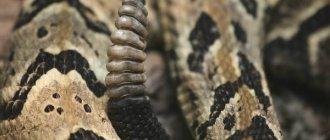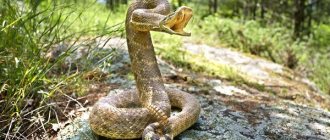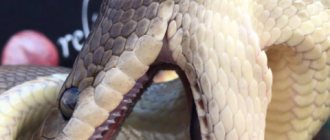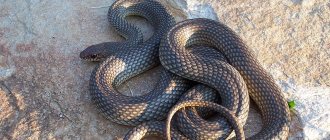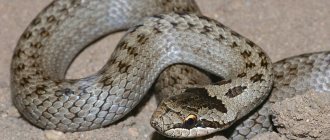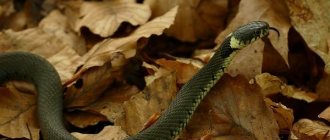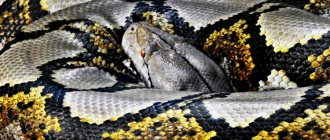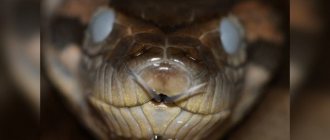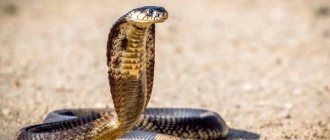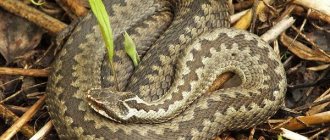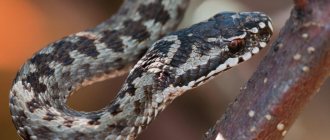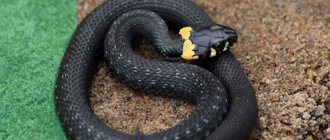- Reptiles
California king snake
(
Lampropeltis zonata
) - Non-venomous snake of the colubridae family (
Calubridae
). Today there are about fourteen species, the main habitat of which is North and Central America, as well as Mexico.
Appearance and description of king snakes
The king snake received its second name “sparkling shield” due to the presence of very specific dorsal scales. The king snake was nicknamed because in the wild, other types of snakes, including poisonous ones, became its favorite treat. This feature is due to the lack of sensitivity of the king snake’s body to the poisons of its relatives.
This is interesting! There are documented cases in which members of the kingsnake genus ate the most dangerous rattlesnakes.
Currently, only seven subspecies belonging to the genus of king snakes have been studied quite well. All types have significant differences not only in color, but also in size. Body length can vary from 0.8 m to one and a half to two meters. As a rule, the scales of snakes of this genus are smooth, have a bright and contrasting color, and the main pattern is represented by numerous multi-colored rings. The most common combination is represented by red, black and white.
Why are milk snakes unusual?
When you first look at these snakes, the thought immediately comes to you: why are they “milk”, because their colors are very bright? The snake has a bright scarlet color, and its body is surrounded by yellow and black rings.
The Sinaloyan kingsnake, using mimicry, is very similar to the poisonous coral adder.
The thing is that in places where milk snakes live, cattle may lose milk for some reason. American farmers believe that someone is sucking this milk. And the culprit was quickly found - a brightly colored snake often found in pastures. This is where its name comes from.
Interestingly, many city residents also think that snakes love milk and lap it up from a saucer. If you do not give the snake water, it will indeed drink milk, but this will only cause intestinal upset.
When getting to know these snakes, a second question also arises: since they have such a bright color, do they mean they are poisonous? No, this is a manifestation of mimicry; milk snakes, due to their coloring, imitate poisonous coral snakes.
Main types
Let's look at several main types of these snakes.
California king snake
What it looks like. Slender and muscular body 0.6–1 m long. There are red spots on the slightly elongated head with a blunt muzzle. The body is decorated with a pattern in the form of alternating rings - black and white. Most often, the black rings are divided into two parts by a red stripe, which sometimes closes on the stomach. Some subspecies do not have a red tint in color. The upper part of the head is black with a light transverse stripe or lateral spots.
Where he lives. Distributed from the north of the California Peninsula (Mexico) to the southern part of Oregon (USA), including all of California. A separate group is observed in the south of the American state of Washington. Prefers mountainous terrain.
What does it eat? Rodents, lizards, snakes, birds, eggs.
Did you know? According to the Guinness Book of Records, the world's largest reptile, an 18-year-old python named Fluffy, lives at the Ohio State Zoo (USA). This record holder is more than 7 meters long and weighs as much as 136 kg!
Striated
What it looks like. The length reaches 1.3 meters. The coloration is reminiscent of poisonous coral adders and is a combination of rich shades of red, black and white.
Where he lives. North America (from Colombia to Canada).
- What kind of snakes are kept at home?
- Ancient dog breeds
- Dog's sense of smell
- Maine Coon
- Domestic iguana
- How much does a raccoon cost?
What does it eat? Small lizards, various amphibians and large insects.
Common kingsnake
What it looks like. The average length is 1–1.4 m, the maximum reaches 2 m. A triangular head is located on the slender body. It is painted brown or black with light transverse stripes in the form of an elongated chain. The abdomen is dark in color with a pattern of several light stripes.
Where he lives. Starting from southern New Jersey to northern Florida (USA). Prefers to settle in deciduous and coniferous plantations, meadows, and swampy areas.
What does it eat? Small lizards, snakes. Find out which snakes are the largest and which are the most beautiful.
Mexican black
What does it look like ? The average length is 0.9–1 m, but can reach up to 2 m. The slightly elongated head is flattened on both sides. The muscular gray or brown body is decorated with irregular patches of red or black and red with a light border. The head is marked with a dark pattern resembling the letter "U". Gray belly, sometimes red coloring at the bottom of the tail.
Where he lives. Northwestern Mexico and the US state of Texas. Likes to settle in dry rocky places.
What does it eat? Small lizards, rodents and snakes.
Arizona
What it looks like. The length ranges from 50 to 100 cm. Slender body with a compact and slightly rounded head. The top of the head is almost black, the tip of the nose is light, and there are red areas above the eye sockets. The body is covered with a pattern of red, black and light stripes. The back is black, on the stomach there is a pattern in the form of uneven areas of red, black and yellow.
Where he lives. Central and southeastern Arizona (USA), through northern Mexico to Chihuahua and Sonora. More often it lives in the mountains, among coniferous plantations, and loves rocky soil.
What does it eat? Lizards and rodents. Important! The king snake quickly gets used to its owner, becomes almost tame and does not show any aggression. At the same time, you should accustom your pet to handling hands gradually, starting with 5-10 minutes of communication a day.
Campbell's king milk snake
What it looks like. The length reaches 0.9 m. The color looks like alternating red, black and white stripes. The head is dark, the first light stripe extends to the temple and sometimes reaches almost to the tip of the muzzle. The dark stripes are much thinner than the red and white ones; in some representatives of the species the red color is almost absent.
Where does it live ? Mexico. Settles in mountain valleys, forests, and floodplains.
What does it eat? Small rodents, lizards, snakes. Familiarize yourself with the features of keeping a milk snake in a terrarium.
Mountain
What it looks like. The average length is 0.8–0.9 m, the maximum length is 1.5 m. A strong muscular body is crowned with a pointed head. Its shade is black, steel or gray. The snake's coloration is a dark gray background with wide, saddle-shaped orange areas.
Where he lives. Southern territories of Texas and New Mexico (USA), Mexican province of Chihuahua. Settles in rocks and forests.
What does it eat? Lizards, mice, amphibians.
Beautiful king snake
What it looks like. The length reaches 0.75–1 m. The strong body ends with a slightly elongated head, flattened on both sides. Background color - from fawn to brown. The pattern is red or brown rectangular spots located across the body. The abdomen has a beige or yellowish tint with dark areas. There are specimens of red and pink color without dark colors.
Where he lives. Central and southeastern United States from Texas to Florida and North Carolina. Settles in prairies, open forests, and forest clearings.
What does it eat? Rodents, frogs, birds, snakes.
Did you know ? Despite its small head measuring only 1 centimeter, the African snake can swallow an egg 5-6 times larger. This is helped by the special structure of the snake’s lower jaw, which can diverge to accommodate large prey. As soon as the egg is inside, special vertebrae open the shell, and the reptile regurgitates its pieces out.
Fer-de-lance pit viper
Fer-de-lance is a poisonous viper from Central and South America.
Fer-de-lance pit viper
The bite can turn a person's body tissue black as it quickly begins to die. These pit vipers, native to Central and South America, reach a length of 1.2-2.5 m and a weight of up to 6 kg.
They are responsible for approximately half of all snake poisonings in Central America. (According to a 2001 study published in the journal Toxicon). Because Fer-de-Lance's venom contains an anticoagulant (a substance that prevents blood from clotting), a bite from this snake can cause bleeding in humans.
- Habitat: Central and South America
And if that doesn't put you off traveling to Central America, consider this: According to the University of Costa Rica, a female can give birth to 90 extremely ferocious offspring.
Area
It lives in North America, in the USA - California, Nevada, Arizona, and also in Mexico.
A terrestrial species, it prefers to settle in forests, meadows, mountain slopes, fields, as well as on the outskirts of towns and cities. Swims well and easily climbs trees and bushes.
It is characterized by high ecological plasticity and inhabits a wide range of biotopes, from sand dunes on the sea coast, as well as forests, bushes and prairies, to deserts and rocky beds of dry rivers. The mountains rise to 2164 m above sea level (in the Sierra Nevada). It is also found in anthropogenic landscapes: along the edges of fields, near roads, in farm yards, in vacant lots and in construction waste dumps.
In the north of the range and in the mountains they are active from April to October, and in the south throughout the year. Like many other species of snakes, seasonal changes in daily activity have been described - in hot weather they are nocturnal, and in spring and autumn they are often found on the surface during the day. It winters in caves, deep burrows of various animals and other underground shelters, where the temperature does not fall below zero. They dig holes themselves extremely rarely. There are known cases of joint wintering of a large number of individuals and wintering with snakes of other species.
Etymology[edit | edit code]
The Russian name for the snake comes from a conditionally direct translation of the American term, [2] which corresponds to the general black tone in the color of the animal, as well as the main habitat and distribution of this type of snake on planet Earth.
Scientific name - lat. Lampropeltis getula nigrita, can be translated and explained with Russian synonyms in the following correspondence of words and their meanings: lat. Lampropeltis - “shiny shield” (from the Greek λαμπρος - “brilliance”, and the Greek πελτα - “scutellum” as a covering
);
lat. nigrita - black / black - like a Moroccan
, which is reflected in some way in the second term of the scientific systematic name of the genus of snakes, since the word in Lat. getula comes from Lat. Getulus, which in turn refers to the people of Morocco - lat. Getulians, who lived and are living in West Africa, in whose tradition it was common to decorate the body in the form of a chain of various ring tattoos and jewelry - as is also observed in the coloring of the clan armor. Lampropeltis getula, that is, a snake with “black shiny shields” or a snake with “black patterned skin.”
Behavior of the California Kingsnake
Snakes are active from late March to early November. In winter, they go deep into rock crevices or hide in mammal burrows, in a state close to suspended animation, although some individuals crawl out to bask on warm stones if the winter is mild.
In spring and autumn it is active during the day; in summer, the California kingsnake hunts at dusk or even at night to avoid exposure to high temperatures during the day.
This type of snake is a good climber; they are able to climb even into hollows to a height of more than 1.5 meters from the surface of the earth. When confronted with an enemy, California king snakes tend to crawl away; if this is not possible, the snakes violently twist their whole body to defend themselves and excrete feces, then inflict rather deep lacerations with their teeth. They search for prey using sight, hearing, and also feel vibrations in the soil.
Some more interesting facts about the king cobra
This snake is not actually a cobra in the literal sense of the word, but it can be classified as a separate species, one of a kind.
It is longer than a real cobra and does not have a specific color in the hood stance. The king cobra is capable of lifting up to one-third of its body length when an attack is imminent or its life is threatened. In addition, she can pursue her prey for some time in this upright position. When the snake is in this position, it can reach a vertical height of up to 1.8 meters (6 feet).
Feeding
In the wild, the diet of Lampropeltis getulus californiae depends on the habitat, as it is largely an opportunistic reptile and will eat almost anything it can swallow. Thus, the prey of California king snakes are rodents, small mammals, lizards and their eggs, snakes (including rattlesnakes) and their eggs, frogs, salamanders, birds, as well as large invertebrates, as well as eggs of birds and turtles.
In captivity, these snakes can be fed with mice and rats of the appropriate size. It is better to give prey killed or thawed to avoid injury to the reptile. To diversify the diet, you can offer the snake quail eggs. Prey bones and egg shells are a good source of calcium, but it can also be added as part of a special vitamin and mineral complex for reptiles.
Adults should be fed once a week, or when the snake has completely defecated. Young animals can be fed twice a week, so the baby snake will grow faster. At the same time, it is important to prevent obesity in adults and reduce the amount of food if necessary.
Coastal taipan
Coastal taipans are incredibly fast and can leap into the air with their fangs bared to attack.
Coastal taipan
You may be bitten several times before you know about the coastal taipan (Oxyuranus scutellatus). This is possible thanks to its incredible speed, says the Australian Museum. When threatened, this snake, which lives in the moist forests of temperate and tropical coastal regions, lifts its entire body off the ground, leaps forward with extraordinary precision with its fangs and injects venom into its enemy.
- Habitat: Australia), southeast New Guinea
Until 1956 (when an effective antidote was developed), the bite of this snake was almost always fatal.
Reproduction
The species is an oviparous snake. Californian snakes reach sexual maturity at 3-4 years. Mating occurs after hibernation ends, usually between early April and late May. The female lays 4 to 10 eggs in a secluded place.
Sometimes there may be a larger number of eggs in a clutch, which depends on the age of the female and her fatness. Incubation lasts about 50-70 days at ambient temperature.
Young snakes hatch from eggs fully formed and ready for independent life. Their body length is about 30 cm. In the first year of their life, they feed mainly on lizards; in captivity, they can be fed to young rodents.
The California kingsnake occupies an important place in the ecosystem, containing the growth of amphibians, venomous snakes and small mammals. In turn, it itself is food for birds of prey and coyotes.
Nutrition
Cobras feed on small rodents, birds (passerines and ground-nesting birds, for example, nightjars), lizards, frogs, toads, smaller snakes, and eggs. The king cobra feeds exclusively on reptiles, and eats lizards extremely rarely, and more often hunts other snakes. Its victims are usually the most poisonous species and the closest relatives of cobras - kraits and asps. Cobras kill their prey with a bite, injecting strong poison into its body. Interestingly, cobras often sink their teeth into the victim and do not immediately release it, as if chewing, thereby ensuring the most effective introduction of the toxin.
King cobra venom
King cobras are able to regulate the flow of venom during an attack by closing the ducts of the poisonous glands through muscle contractions. The amount of poison consumed depends on the size of the victim and is usually almost an order of magnitude higher than the lethal dose. The neurotoxin of its venom does not affect the snake itself, and it does not get poisoned when eating a victim it has poisoned. Most often, in an attempt to scare away a person, the snake makes “idle” bites, without injecting any poison at all.
Apparently, this is due to the fact that the cobra needs venom primarily for hunting, and accidental or unnecessary loss of venom is undesirable. King cobra venom is primarily neurotoxic. The venom toxin blocks muscle contractions, which causes paralysis of the respiratory muscles, respiratory arrest and death.
Its strength and volume (up to 7 ml) are enough to cause the death of a person within 15 minutes after the first full bite. In such cases, the probability of death may exceed 75%. But, taking into account all the behavioral features of the king cobra, in general, only 10% of bites become fatal to humans. However, there have been cases where even Indian elephants have died three to four hours after a king cobra bite if the bite was inflicted on the end of the trunk or on the fingers (the only parts of an elephant’s body that are vulnerable to snake bites. In India, cases of death from a king cobra bite are rare, with that every year up to 50 thousand people die from poisonous snake bites in the country.
Diseases
When kept in a terrarium, king snakes are very susceptible to fungal skin diseases - mycoses . They occur when sanitary and hygienic maintenance rules are violated, as well as excess substrate moisture. Appropriate antibiotics are appropriate for treatment.
Refusal to eat can be caused by stress, an unsuitable food item, a new food item, an unusual food item for the species, or the snake is simply not hungry. You shouldn’t force-feed a snake right away, because they can live long enough without food without harm to their health. You should start to worry if the snake does not eat for several months. Then you need to analyze the conditions of detention and the diet of the snake before the problem begins. As a last resort, you can feed the snake artificially.
Regurgitation can occur due to stress, illness, too much food, feeding during molting, or temperature disturbances. After regurgitation, you should not feed the snake for 7–10 days, then you should feed the snake again, taking into account the error analysis.
Shedding is not a disease, but a necessary stage of snake growth. At the same time, the snake’s eyes become cloudy, the color brightens, and the skin begins to peel off. During this period, you should monitor the humidity in the terrarium and the presence of a reservoir.
Ticks are small parasites that live on the skin of a snake; they attach themselves to the snake between its scales and suck blood. At the same time, the snake becomes slow and may refuse food. The snake is usually treated with a weak solution of Frontline, a tick medicine for dogs and cats). It is also necessary to disinfect the entire terrarium.
Respiratory infections - they are usually caused by opportunistic bacteria when the snake’s immunity is reduced as a result of stress due to improper conditions. Symptoms: difficulty breathing, open mouth, nasal discharge. It is treated with an antibiotic - baytril, by injection.
Tape krait
The venom of the ribbon krait prevents the victim's lungs from working efficiently.
Tape krait
The Ribbon Krait (Bungarus fasciatus) moves slowly during the day and is much more likely to bite after dark. This snake's venom can paralyze muscles and prevent the diaphragm from moving, according to a 2016 study published in the journal PLOS Neglected Tropical Diseases.
As a result, air stops flowing into the lungs, which leads to suffocation.
- Habitat: India, southern China, Burma and Thailand
This snake is mainly active during twilight and night time, so be careful when walking at night.
Meaning for humans
The California king snake is often kept as a pet; the main positive qualities of this type of snake are its attractive coloration and lack of venom. In addition, the California king snake is bred in zoos and attracts visitors with its bright skin color. Breeding this species of snake in captivity reduces the capture of individuals in the wild, which significantly increases the chances of survival of the species.
The California king snake does not cause any harm to people; in case of danger, it tries to escape and attacks only when absolutely necessary. Despite its bright warning coloration, the California kingsnake simply mimics the venomous appearance of snakes, its coloration resembling the pattern of a coral adder.
Enemies of the king cobra
Hannah is undoubtedly extremely poisonous, but she is not immortal. And she has several natural enemies, which include:
- wild boars;
- snake eagles;
- meerkats;
- mongooses.
The last two do not give king cobras a chance to survive, although they do not have innate immunity against king cobra venom. They have to rely solely on their reaction and dexterity, which rarely fails them. The mongoose, seeing a cobra, gets into the excitement of the hunt and does not miss the opportunity to attack it.
The animal knows that Hannah is somewhat lethargic and therefore uses a well-practiced tactical technique: jump, jump back, and rush into the fray again. After a series of false attacks, one lightning-fast bite to the back of the head follows, leading to the death of the snake.
Its offspring are also threatened by larger reptiles. But the most ruthless exterminator of the king cobra was the man who killed and captured these snakes.
Conservation status
The California kingsnake is listed as a species of special concern on the California Snake Species List, and some populations are protected. The IUCN Red List ranks the California kingsnake as a species of Least Concern.
Habitat destruction associated with urbanization and mining are the most common threats to this species, and the reptile is a traded species. Some habitats of the California kingsnake lack measures to prevent the illegal taking of snakes. These snakes breed in captivity and produce offspring, which may be why they have avoided further decline in numbers in the wild.
Russell's viper
This species is considered one of the deadliest among true vipers.
Daboia russelii - Russell's viper
About 58,000 deaths in India each year are attributed to snakebites. The Russell's snake (Daboia russelii) is responsible for the majority of these deaths. (According to a study dated March 25, 2022 in the journal PLOS Neglected Tropical Diseases). This species is considered one of the deadliest among true vipers.
In Sri Lanka, this nocturnal viper likes to rest in rice fields. It causes high mortality among rice farmers during harvest.
The snake's venom can lead to a terrifying array of symptoms: acute kidney failure, severe bleeding and damage to multiple organs, researchers reported in 2014 in the journal Handbook of Clinical Neurology.
Some components of the venom associated with blood clotting can also lead to acute stroke. In rare cases, symptoms similar to Sheehan syndrome, in which the pituitary gland stops producing hormones.
- Habitat: India, Sri Lanka
However, victims most often die from kidney failure, the guide says.
Keeping a king snake at home
Medium-sized varieties that are undemanding and quite easily adapt to the conditions of terrariums are best suited for home keeping. The owner of the reptile will need to purchase a standard set of equipment.
Setting up a terrarium for a snake
The optimal type for keeping a king snake would be a horizontal type terrarium, the minimum dimensions of which are 800x550x550 mm. For small individuals, you can select a terrarium measuring 600x300x300 mm.
The bottom part should be covered with a special artificial mat or covered with high-quality coconut shavings. A less suitable option would be to use paper.
This is interesting! As decorative items, you can use small caves, large pieces of bark or not too large driftwood.
A small pool should be installed in the corner of the terrarium for bathing the snake . A hydrometer and thermometer are attached to the wall of the terrarium, allowing strict control of the microclimate. The optimal temperature during the day is 25-32°C. At night, the temperature should be lowered to 20-25°C. The standard humidity level should be between 50-60%. Spraying is carried out if necessary.
When keeping reptiles, it is important to have proper lighting using fluorescent lamps, which should not be too bright. To heat the terrarium, you can use several incandescent lamps, but it is best to use special thermal mats for this purpose, which are placed in one of the corners of the terrarium.
Important! To maintain the health of reptiles, you need ultraviolet lamps, which need to be turned on every day for half an hour.
Home cleaning
Usually, 2-3 days after feeding, the snake leaves feces, which must be removed immediately to prevent the growth of pathogenic bacteria in it.
In addition, to ensure cleanliness in the terrarium, general cleaning should be done 1-2 times a month, during which the bedding or soil should be completely changed or cleaned, and equipment and decorative items should be cleaned and disinfected. Step-by-step instructions for cleaning the terrarium:
- Move the snake to a separate, clean terrarium.
- Wash all decorative items, food and water containers with hot soapy water, and then rinse well with clean running water.
- Remove the disposable substrate from the terrarium. Clean reusable with hot soapy water and rinse thoroughly.
- Wash the floor and walls of the home and rinse well.
- Dry the terrarium and all accessories well to avoid mold.
- Assemble the terrarium and install decorative items.
So now you know that keeping a king snake is not the most difficult task. Caring for it does not take much time, and the pleasure of observing this bright miracle of nature is enormous!
Photo gallery[edit | edit code]
- Young black Mexican kingsnake in human hands
- Adult snake chocolate-colored in color
- Black Mexican kingsnake strangling a mouse
- Skin plates - scutes of the black Mexican king snake Lampropeltis getula nigrita
- Head of a black Mexican kingsnake Lampropeltis getula nigrita
- The tongue of the black Mexican kingsnake is one of the strongest sensory organs of smell and touch.
- The long forked tongue of the black Mexican kingsnake is larger than its head.
- In childhood and adolescence on the body Lampropeltis getula nigrita
there may be various white or yellowish spots
- Such spots on the black Mexican kingsnake disappear with age.
- Abdomen of a black Mexican kingsnake Lampropeltis getula nigrita
- Young tame pet Lampropeltis getula nigrita
in the hands of a man
- To control the temperature and humidity in the terrarium, various types of thermometers, thermostats and hydrometers are used
- Black Mexican kingsnake before molting
- Crawling out of a black Mexican kingsnake after molting
Buy a king snake - recommendations
Newly purchased snakes must be kept in a quarantine terrarium, which will identify any health problems with the reptile. It is best to keep such a snake in an isolated area to prevent airborne infection of other pet reptiles.
It is necessary to carefully examine the snake for the absence of external parasites. During the quarantine process, it is necessary to monitor the reptile's stool and nutrition. If you have no experience, it is advisable to show the snake to a qualified veterinarian after purchasing. It is best to purchase a reptile in special zoological nurseries and stores or from well-established breeders.
Where to buy a snake and what to look for
The cost of a king snake may vary depending on the place of purchase, as well as the species and age. Average price in Moscow pet stores and nurseries:
- Californian king snake HI-YELLOW – 4700-4900 rubles;
- Californian king snake BANDED – 4800 rubles;
- royal Honduran snake HI-WHITE ABERRANT – 4800 rubles;
- Californian king snake Albino Banana – 4900 rubles;
- Californian king snake Banded Cafe – 5,000 rubles;
- royal Honduran snake HYPOMELANISTIC APRICOT – 5000 rubles;
- Californian king snake Albino – 5,500 rubles;
- Huachuk mountain king snake – 5,500 rubles.
Important! When purchasing, you need to pay attention that a healthy reptile has sufficient weight and does not suffer from anorexia.
It is necessary to examine the oral cavity, which should be free of oral fungus caused by staphylococci. You should check your reptile for mites, which cause skin irritation, and when and how it last shed its skin. A completely healthy reptile must get rid of its old skin at one time.
In recent years, many owners of king snakes have implanted a special microchip into their pets, which allows them to track their location if necessary. This is a very simple operation, and the unique number contained on the chip allows you to effectively control the reptile.
Video
Habitats and distribution[edit | edit code]
Loading map... 22.268764-94.5703132 250
{"type":"Feature", "properties":{}, "geometry":{"type":"Polygon", "coordinates":[[[-92.179687432945, 15.012597441673], [-91.652343682945, 16.155175566673], [ -90.246093682945, 16.243066191673], [-91.124999932945, 17.297753691673], [-90.685546807945, 18.088769316673], [-89.015624932945, 1 7.649316191673], [-88.136718682945, 18.440331816673], [-86.818359307945, 21.077050566673], [-87.697265557945, 21.692284941673], [- 90.158203057945, 21.077050566673], [-91.124999932945, 19.055566191673], [-94.201171807945, 18.264550566673], [-95.958984307945, 1 8.616113066673], [-97.277343682945, 20.901269316673], [-97.892578057945, 23.801659941673], [-97.277343682945, 25.998925566673], [-98. 683593682945 , 26.262597441673], [-99.650390557945, 27.493066191673], [-101.32031243294, 29.602441191673], [-102.55078118294, 30.041894316673], [-104.22070305794, 31.799706816673], [-106.41796868294, 33.821191191673], [-112.65820305794, 34.084863066673], [-114.06445305794, 33.293847441673], [-115.91015618294, 32.942284941673], [-116.87695305794, 32.414941191673], [-116.08593743294, 30.217675566673], [- 115.20703118294, 28.371972441673], [-113.18554680794, 26.350488066673], [-110.63671868294, 23.450097441673], [-109.40624993294, 22. 746972441673 ]. , 31.096581816673], [-114.41601555794, 31.623925566673], [-113.18554680794, 30.920800566673], [-112.30664055794, 28.899316191673] , [-108.52734368294, 25.032128691673], [-105.53906243294, 21.868066191673], [-105.53906243294, 20.286034941673], [-103.51757805794 , 18.176659941673], [-98.507812432945, 16.155175566673], [-96.310546807945, 15.452050566673], [-94.464843682945, 16.155175566673], [-93.058593682945, 15.452050566673], [-92.531249932945, 15.012597441673], [-92.443359307945, 15.364159941673], [-92.267578057945, 15.452050566673], [-92.355468682945, 15.276269316673], [-91.916015557945, 15.803613066673], [-91.652343682945, 16.155175566673], [ -91.564453057945, 16.330956816673], [-91.652343682945, 16.418847441673], [-91.300781182945, 16.330956816673], [-92.179687432945, 1 5.012597441673]]]}, "crs":{"type":"name", "properties":{"name »:»urn:ogc:def:crs:OGC:1.3:CRS84″}}}
Distribution area of lat. Lampropeltis getula nigrita
The described species lives on rocky areas in areas with rich and lush vegetation in various regions of the southeastern territories of the United States of America and in Mexico: - in the Sonoran Desert, in Northwestern Sinaloa, throughout Mexico and in a small part of Arizona, where they have been recently discovered and described that are a cross between the black Mexican kingsnake (Lampropeltis getula nigrita), the California kingsnake (Lampropeltis getula californiae) and/or the black desert kingsnake (Lampropeltis getula Splendida): various species and the subspecies of kingsnake often interbreed in the area and may no longer be a “pure species” - the black Mexican kingsnake (Lat. Lampropeltis getula nigrita).[3] Although black Mexican kingsnakes are a terrestrial animal, they climb into low-growing shrubby vegetation, mastering these spaces, and are also excellent swimmers.
Rainbow snake
A very beautiful and rare snake on our planet called the Rainbow (Shieldtail) is really very similar to a rainbow, as it shimmers with all the colors of the rainbow, and its color sparkles like mother-of-pearl in the sun.
Its distinctive feature is its bright and neon-like color. Look for yourself, isn't she a beauty?
Looking at it, fear of the reptile gives way to surprise and admiration.
You can meet a snake in India and Pakistan, but this is only if you are very lucky. But very little is known about her, so let’s better admire her in our photos.
?
Green python
This may surprise you a little now, but a green python does not immediately turn green. Newborn pythons have an orange and even slightly reddish tint. And only when the python turns one year old, the scales change their color to bright green.
Representatives of this species reach a length of up to 2 meters. Their diet consists of lizards, small birds and rodents.
12
National economic significance[edit | edit code]
Snakes and products or goods made from snakes are of great economic importance: haberdashery products are made from the skins of snakes - wallets, handbags, gloves, ties and trimmings for outerwear, shoes; [18] the meat of some types of animals is traditionally used for food, and some parts of the body and secretions - as raw materials for the manufacture of medicines, and - in addition, snakes themselves are excellent rodent hunters - saving the reserves of private and public households from ruin and the spread of various infections.
Notes and links[edit | edit code]
- To help the terrariumist “English-Russian dictionary of the names of reptiles and amphibians”
- Black Mexican king snake#Variations in the name of the animal
- Hubbs, Brian "Common Kingsnakes", Tricolor Books, Tempe, AZ - 2009 ISBN 0975464116
- ↑ a b c d Black Mexican king snake#Photo gallery
- Probe for determining the sex of a snake
- A black Mexican kingsnake swallows a corn snake
- Wilson, Don "Animal: The Definitive Visual Guide to the World's Wildlife." DK Publishing, New York, NY - 2001 ISBN 0756686776
- Bauchot, Roland "Snakes: A Natural History". Sterling Publishing, New York, NY - 1997 ISBN 1402731817
- Mattison, Chris "The Essential Visual Guide to the World of Snakes." DK Publishing, New York, NY - 2006 ISBN 078944660X
- Kingsnakes and Milksnakes
- Mating of a black Mexican kingsnake with a corn snake of morphological variation
- Catalog of natural leather and handmade furs.
| Now you are on the page of a dictionary entry explaining the meaning of a word, abbreviation or phrase, which can be expanded and supplemented by you with audiovisual material, alternative additions to well-known explanations, historical information, a method of manufacturing or using what is being described, links to external Internet sources and literature , as well as other sections up to an encyclopedic article. If you got here by mistake from one of the “Traditions” articles, please go back and rewrite the data so that it directly points you in the right direction to the article you need to explain the word or term. |
